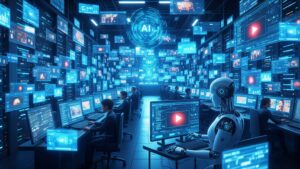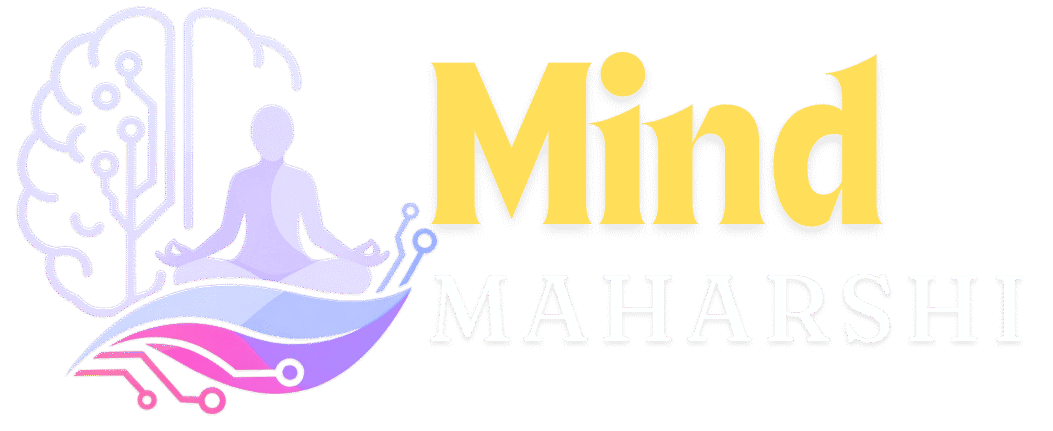AI content creation- Imagine a world where 90% of online content could be generated by machines by 2030. While a precise figure is hard to pin down, the rapid advancements in AI suggest we’re heading towards an unprecedented explosion of machine-generated text, images, audio, and video. This isn’t science fiction; it’s the reality of AI content creation today. At its core, AI content creation refers to the use of artificial intelligence technologies, particularly generative AI, to autonomously produce various forms of content. This article will delve into the transformative benefits and profound impact of AI on diverse industries, exploring the challenges it presents and what the future holds for this revolutionary technology.
What Is AI Content Creation?
AI content creation involves leveraging artificial intelligence algorithms to generate new and unique content without direct human input for every word or pixel. For beginners, think of it as teaching a highly intelligent machine to “create” based on patterns and vast amounts of data it has learned from.
At its heart lies generative AI, a subset of AI that can produce novel outputs like text, images, or even code. This is powered by sophisticated models, most notably Large Language Models (LLMs) like those behind ChatGPT, which are trained on massive datasets of text and code to understand and generate human-like language. Deep learning, a form of machine learning, is the engine that allows these models to learn complex patterns and make intelligent predictions or creations.
Popular tools currently at the forefront of this revolution include text generators like ChatGPT and Jasper, and image generators such as DALL·E and Midjourney, all of which demonstrate the remarkable capabilities of generative AI in producing diverse content.
The Rise of Generative AI
The journey of AI content creation began with early forms of automation, such as simple template-based text generation. However, the true “boom” we are experiencing today is a recent phenomenon. This surge can be attributed to several critical factors: the availability of big data for training increasingly complex models, exponential increases in computing power (particularly with GPUs), and the proliferation of open-source models that have democratized access to powerful AI technologies, fostering rapid innovation and widespread adoption.
How AI Content Creation Is Reshaping Industries
AI content creation isn’t just a niche tool; it’s a powerful force fundamentally altering operations across a multitude of sectors.

Marketing and Advertising
In marketing and advertising, AI content creation is a game-changer. It enables automated copywriting for headlines, ad copy, and social media posts, significantly speeding up campaign creation. Furthermore, it allows for personalization at scale, tailoring messages and offers to individual consumers based on their preferences and behaviors, leading to higher engagement and conversion rates.
Publishing and Journalism
For publishing and journalism, AI is becoming an invaluable assistant. It can generate AI-assisted article drafts from data or outlines, helping reporters and editors to quickly produce content. Crucially, AI-powered fact-checking and editing tools are enhancing accuracy and streamlining the editorial process.
E-commerce
E-commerce businesses are leveraging AI for efficient content generation. AI can automatically write engaging product descriptions for thousands of items, saving immense time and resources. It also powers personalized recommendations, suggesting products to customers based on their Browse history and purchase patterns, boosting sales.
Design and Visual Media
The world of design and visual media is being revolutionized by AI. Tools can create stunning AI-generated images for marketing campaigns, website assets, and even branding materials. Beyond static images, AI is also making strides in video generation and editing, automating tasks like scene compilation and adding effects.
Entertainment & Gaming
In entertainment and gaming, AI is adding new dimensions to creativity. It can assist in storyline generation, providing writers with new plot twists and character arcs. In video games, AI is crucial for creating realistic and dynamic NPC (Non-Player Character) dialogue, making game worlds more immersive and interactive.
Education and E-learning
Education and e-learning platforms are using AI to enhance the learning experience. AI can generate AI-created course content, including summaries, explanations, and even entire modules. It also powers dynamic quizzes and study aids that adapt to individual student progress and learning styles.
Healthcare and Legal
Even traditionally conservative sectors like healthcare and legal are benefiting. AI can quickly generate summaries of complex documents, such as medical research papers or legal precedents, saving professionals valuable time. It’s also being used to create clear and concise patient education material, improving communication and understanding.
Benefits of AI Content Creation
The advantages of embracing AI content creation are numerous and compelling:
- Speed and scalability: AI can produce content at a pace and volume impossible for human teams.
- Cost savings: Automating content generation reduces the need for extensive human resources.
- Improved personalization: AI can tailor content to individual users, leading to higher engagement.
- 24/7 content production: AI tools can operate continuously, ensuring a constant stream of content.
Challenges and Ethical Concerns
Despite its promise, AI content creation is not without its challenges and ethical considerations:
- Quality control: While AI is advanced, human oversight is still crucial to ensure accuracy, relevance, and brand voice.
- Copyright and originality: Questions arise regarding the ownership and originality of AI-generated content, especially when models are trained on existing copyrighted material.
- Misinformation and bias: AI models can inadvertently perpetuate biases present in their training data, leading to biased or even false content. There’s also the risk of AI being used to generate and spread misinformation at scale.
- Impact on creative jobs: Concerns exist about the potential displacement of human creatives as AI tools become more sophisticated.
Future Trends in AI Content Creation
The landscape of AI content creation is constantly evolving, with several exciting trends on the horizon:
- Multimodal AI: The ability of AI to seamlessly generate and integrate different content formats (text + images + video) will become more prevalent, leading to richer and more dynamic content.
- Human-AI co-creation workflows: Rather than full automation, the future will likely see more collaborative workflows where AI acts as a powerful assistant, augmenting human creativity and efficiency.
- Regulatory frameworks on AI content: As AI content becomes more widespread, governments and organizations will likely establish clearer guidelines and regulations regarding its use, transparency, and accountability.
How to Use AI Content Creation Responsibly
To harness the power of AI content creation effectively and ethically, certain best practices are essential:
- Best practices for brands and creators: Clearly disclose when AI has been used, maintain transparency, and prioritize factual accuracy.
- Human editing and oversight: Always review and refine AI-generated content. AI should be seen as a tool to assist, not replace, human creativity and critical thinking.
- Tools for detecting AI-generated content: Utilize and support the development of tools that can identify AI-generated content to combat misinformation and ensure authenticity.
Conclusion
The AI content creation revolution is here, fundamentally altering how content is produced and consumed across virtually every industry. From enhancing efficiency and personalization to democratizing content creation, its impact is undeniable. However, it’s crucial to acknowledge and address the associated challenges, including quality control, ethical concerns, and the need for human oversight. Ultimately, AI serves as a powerful tool, an amplifier of human potential, not a replacement for human creativity and judgment. By understanding its capabilities, embracing responsible practices, and staying abreast of future trends, individuals and organizations can navigate this exciting new era and unlock the immense potential of AI content creation. We encourage readers to explore these new AI tools responsibly and thoughtfully, recognizing the profound shifts they bring to the world of content.
